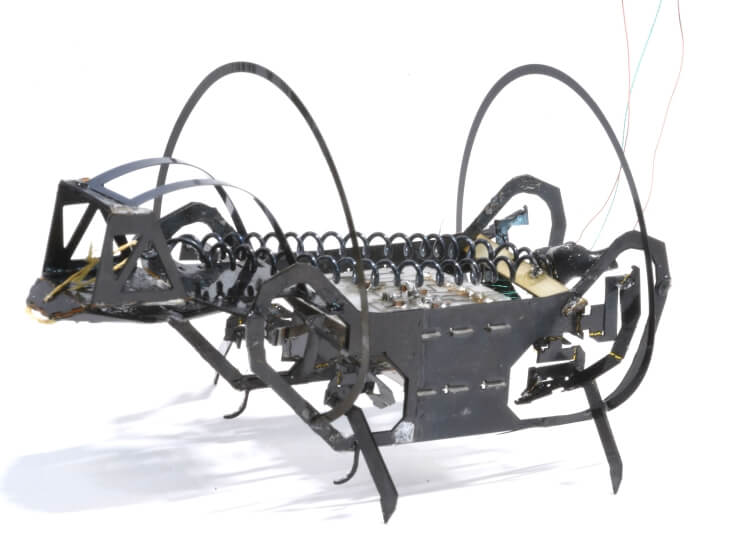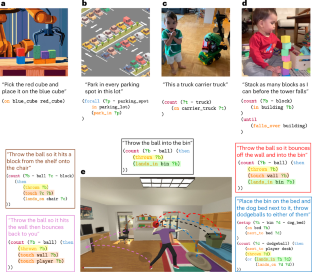2025-02-26 ハーバード大学

The Harvard Ambulatory Microrobot modified with its springtail-inspired jumping mechanism.
<関連情報>
- https://seas.harvard.edu/news/2025/02/springtail-jumping-robot
- https://www.science.org/doi/10.1126/scirobotics.adp7854
- https://www.pnas.org/doi/10.1073/pnas.2026833118
スプリングテールに触発されたマルチモーダル歩行・跳躍マイクロロボット A springtail-inspired multimodal walking-jumping microrobot
Francisco Ramirez Serrano, Nak-seung Patrick Hyun, Emma Steinhardt, Pierre-Louis Lechère, and Robert J. Wood
Science Robotics Published:26 Feb 2025
Abstract
Although legged robots have demonstrated effective mobility in some natural settings, as robot size decreases, obstacles in their environment become challenging to overcome. Small arthropods scale obstacles many times their size through jumps powered by mechanisms that overcome speed and power limitations of muscle alone. The motivation for this study was to explore the marriage of impulsive (jumping) and nonimpulsive (cyclic legged ambulation) behaviors in a centimeter-scale robot. Here, jumping is achieved by striking the ground with a bioinspired appendage connected to a parallel linkage. As the linkage configuration passes through the singularity, a torque reversal occurs whereby elastic energy slowly stored by force-dense velocity-limited shape memory alloy actuators is rapidly released. A passively driven elastic hinge is introduced in the striking arm to mediate ground contact forces and direct jumping. High-speed video recording of the 14-millisecond launch phase reveals previously undocumented takeoff dynamics closely resembling those of springtails. A dynamic model was derived, and an experimentally validated simulation was used to optimize the design of key components. The 2.2-gram, 6.1-centimeter-long mechanism achieved a maximum horizontal jumping distance of 1.4 meters (23 body lengths), surpassing that of similarly sized insects. The mechanism was integrated with an agile quadrupedal microrobot with leg articulation suitable to achieve the ideal jumping posture. The platform demonstrated repeatable directional takeoffs and upright landings, enabling complex maneuvers to overcome obstacles and gaps. Last, we used this bioinspired robot to offer reflection on hypotheses related to springtail jumping behavior.
超高速系のダイナミクスを探るためのシャコの物理モデル A physical model of mantis shrimp for exploring the dynamics of ultrafast systems
Emma Steinhardt, Nak-seung P. Hyun, Je-sung Koh
Proceedings of the National Academy of Sciences Published:August 13, 2021
DOI:https://doi.org/10.1073/pnas.2026833118

Significance
Many small organisms produce ultrafast movements by storing elastic energy and mediating its storage and rapid release through a latching mechanism. The mantis shrimp in particular imparts extreme accelerations on rotating appendages to strike their prey. Biologists have hypothesized, but not tested, that there exists a geometric latching mechanism which mediates the actuation of the appendage. Inspired by the anatomy of the mantis shrimp striking appendage, we develop a centimeter-scale robot which emulates the linkage dynamics in the mantis shrimp and study how the underlying geometric latch is able to control rapid striking motions. Our physical and analytical models could also be extended to other behaviors such as throwing or jumping in which high power over short duration is required.
Abstract
Efficient and effective generation of high-acceleration movement in biology requires a process to control energy flow and amplify mechanical power from power density–limited muscle. Until recently, this ability was exclusive to ultrafast, small organisms, and this process was largely ascribed to the high mechanical power density of small elastic recoil mechanisms. In several ultrafast organisms, linkages suddenly initiate rotation when they overcenter and reverse torque; this process mediates the release of stored elastic energy and enhances the mechanical power output of extremely fast, spring-actuated systems. Here we report the discovery of linkage dynamics and geometric latching that reveals how organisms and synthetic systems generate extremely high-acceleration, short-duration movements. Through synergistic analyses of mantis shrimp strikes, a synthetic mantis shrimp robot, and a dynamic mathematical model, we discover that linkages can exhibit distinct dynamic phases that control energy transfer from stored elastic energy to ultrafast movement. These design principles are embodied in a 1.5-g mantis shrimp scale mechanism capable of striking velocities over 26 m s−1 in air and 5 m s−1 in water. The physical, mathematical, and biological datasets establish latching mechanics with four temporal phases and identify a nondimensional performance metric to analyze potential energy transfer. These temporal phases enable control of an extreme cascade of mechanical power amplification. Linkage dynamics and temporal phase characteristics are easily adjusted through linkage design in robotic and mathematical systems and provide a framework to understand the function of linkages and latches in biological systems.



